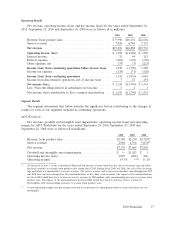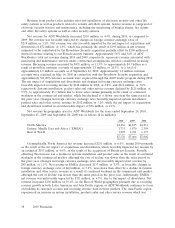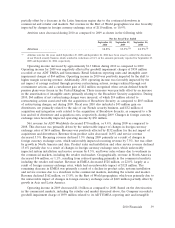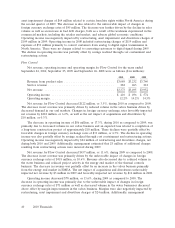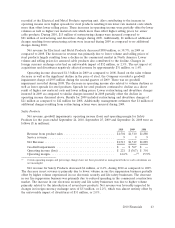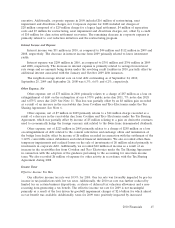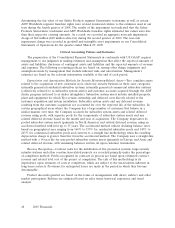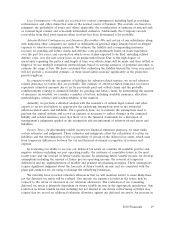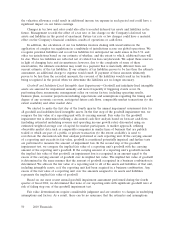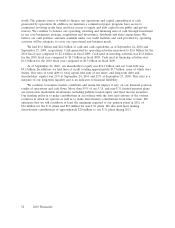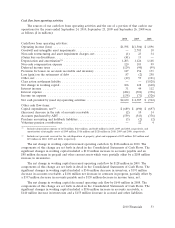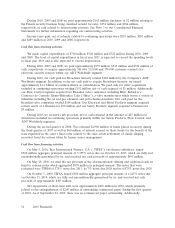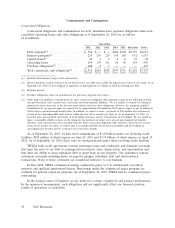ADT 2010 Annual Report Download - page 135
Download and view the complete annual report
Please find page 135 of the 2010 ADT annual report below. You can navigate through the pages in the report by either clicking on the pages listed below, or by using the keyword search tool below to find specific information within the annual report.2009 Goodwill and Intangible Asset Impairments
Annually in the fiscal fourth quarter, and more frequently if triggering events occur, we test
goodwill and indefinite-lived intangible assets for impairment by comparing the fair value of each
reporting unit or indefinite-lived intangible assets with its carrying amount.
We began to experience a decline in revenue during the first quarter of 2009 in our ADT
Worldwide, Fire Protection Services and Safety Products segments as a result of a slowdown in the
commercial markets, including the retailer end market as well as a decline in sales volume at our
Electrical Metal Products segments. Although we considered and concluded that these factors did not
constitute triggering events during the first quarter of 2009, the continued existence of these conditions
during the second quarter of 2009, along with downward revisions to forecasted results, restructuring
actions and weaker industry outlooks, caused us to conclude that sufficient indicators of impairment
existed. Reporting units within ADT Worldwide, Fire Protection Services and Safety Products segments
continued to be negatively impacted as a result of a slowdown in the commercial markets including the
retailer end market. Additionally, our Electrical Metal Products reporting unit continued to be
negatively impacted by a decline in sales volume due to the downturn in the non-residential
construction market. We determined that these underlying events and circumstances constituted
triggering events for six reporting units where such events would more likely than not reduce the fair
value below their respective carrying amounts. Specifically, we concluded that our EMEA Security and
EMEA Fire reporting units within the ADT Worldwide and Fire Protection Services segments, our
Electrical and Metal Products reporting unit within the Electrical and Metal Products segment and our
ACVS, Life Safety and Sensormatic Retail Solutions (‘‘SRS’’) reporting units within the Safety Products
segment experienced triggering events such that the carrying values of these reporting units likely
exceeded their fair values. Furthermore, we determined that certain indefinite-lived intangible assets
required impairment testing based on the underlying events and circumstances described as well as the
continued deterioration of the business environment related to the retailer end market of our ADT
Worldwide and Safety Products segments. As a result of the triggering events, we performed long-lived
asset, goodwill and intangible asset impairment tests for these reporting units and certain of our trade
names and franchise rights.
Fair value of each reporting unit was determined utilizing a discounted cash flow analysis based on
forecast cash flows (including underlying revenue and operating income growth rates) discounted using
an estimated weighted-average cost of capital of market participants. In determining fair value,
management relied on and considered a number of factors, including operating results, business plans,
economic projections including the timing for an economic recovery, cash flow forecasts, market data,
and our overall market capitalization. Based on the factors described above, actual and anticipated
reductions in demand for the reporting unit’s products and services as well as increased risk due to
economic uncertainty, the estimates of future cash flows used in the second quarter of 2009 discounted
cash flow analyses were revised downward from our most recent test conducted during the fiscal fourth
quarter of 2008. Furthermore, the range of the weighted-average cost of capital utilized was increased
to reflect increased risk due to economic volatility and uncertainties related to demand for our
products and services. The results of the goodwill impairment tests indicated that the implied goodwill
amount was less than the carrying amount of goodwill for each of the aforementioned reporting units.
We recorded an aggregate non-cash impairment charge of $2.6 billion ($2.6 billion after-tax) during the
second quarter of 2009. The non-cash impairment charge was recorded in goodwill and intangible asset
impairments in our Consolidated Statements of Operations for the quarter ended March 27, 2009.
Indefinite-lived intangible assets consisting primarily of trade names and franchise rights were
tested for impairment using either a relief from royalty method or excess earnings method, which
include the selection of appropriate discount rates, royalty rates and terminal year growth rate
assumptions and estimates of the amount and timing of future cash flows attributable to the underlying
intangible assets. Also, during the second quarter of 2009, our estimates of future cash flows used in
2010 Financials 47


